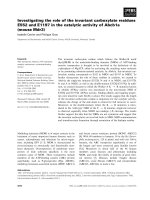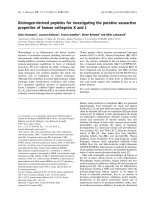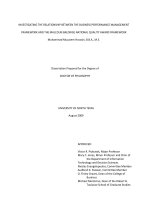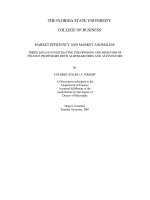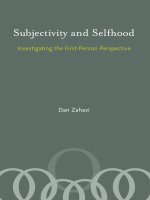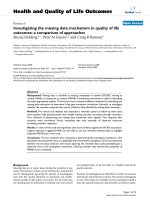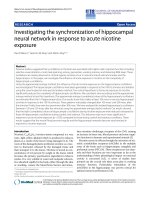Investigating the 2005 singaporean dengue outbreak
Bạn đang xem bản rút gọn của tài liệu. Xem và tải ngay bản đầy đủ của tài liệu tại đây (3.64 MB, 239 trang )
INVESTIGATING THE 2005 SINGAPOREAN
DENGUE OUTBREAK
LUKAS TANNER
B.Sc. (Major in Molecular Biology), University of Basel
A THESIS SUBMITTED
FOR THE DEGREE OF A MASTER OF SCIENCE
IN INFECTIOUS DISEASES,
VACCINOLOGY & DRUG DISCOVERY
YONG LOO LIN SCHOOL OF MEDICINE
NATIONAL UNIVERSITY OF SINGAPORE
&
BIOZENTRUM
UNIVERSITY OF BASEL
2007
Acknowledgments
I would like to thank my supervisor Mark Schreiber for his patience and support
during my masters project. His guidance made my time at NITD a scientific and
educational experience which is invaluable for my future career.
I also thank Liu Wei for taking the time to introduce me to virus work and to the
sequencing project. He provided great support during the vicious times of PCR
optimization.
I would also like to thank Subhash Vasudevan for his fair comments on the project and
for giving me the opportunity to pursue my masters project at NITD.
I am also very grateful to Feng Gu, Katja Fink and Cedric Ng who critically read the
manuscript and provided me with the necessary amendments. I also would like to
mention Robert Zweighardt who took the time to give suggestions from a non-dengue
perspective.
From GIS, I thank Pauline Aw Poh Kim for her part in the sequencing. Without her
effort it would not have been possible to sequence the EDEN isolates. In particular, I
am grateful to Ong Swee Hoe for his phylogenetic analyses and for his helpful
discussions with regard to sequence alignments. He provided me with the necessary
background to be able to understand dengue virus phylogeny. I additionally express
my gratitude to Martin Hibberd for his advice on dengue immunology.
2
I express thanks to the whole EDEN team but especially, to Eng Eong Ooi who
provided me with the clinical and immunological data. It was a pleasure to collaborate
with him and he gave me useful suggestions.
I wish to thank Reinhard Bergmann from NIBR who was helpful in the statistical
analyses. He provided me with the necessary knowledge and always had time to
answer my many questions.
I would like to express my thanks to all the people in the dengue unit who made my
time at NITD not only a scientific but also a personal experience. In particular, I
express my gratitude to Cedric, Viral, Sarah, Joanne, Katja, Indira, Anne, Dina, Mee,
Cheryl, Celine, Alex, Jasmin and Selina who provided me with the necessary
friendship and motivation. It was nice to have Stevie and Tommy as flat mates and
friends. The time with all of you was great and hopefully we will meet someday,
somewhere again…
I am most grateful to my parents Suzanne and Marcel who gave me this unique
opportunity to come to Singapore. Their support in good but especially in difficult
times is invaluable and I am happy to have them as parents. A special thanks goes to
my two sisters Sabine and Catherine. Talking and spending time with them is great and
gives me new energy to go on in my life.
Last but not least, I show gratitude to my friends back home in Switzerland who
always had time to talk to me on the phone. I’ve realized that without their good
friendship I would not have the energy to fulfill my goals…Merci vielmol!
3
Table of Contents
Acknowledgments .......................................................................................................................2
Table of Contents ........................................................................................................................4
Summary....................................................................................................................................10
List of Tables .............................................................................................................................12
List of Figures............................................................................................................................18
List of Abbreviations ................................................................................................................22
1
Introduction ......................................................................................................................24
1.1
Epidemiology of Dengue...........................................................................................25
1.1.1
The Global Emergence of Dengue....................................................................25
1.1.1.1
Situation in the Americas ...................................................................... 26
1.1.1.2
Situation in the Asia/Pacific .................................................................. 27
1.1.1.3
Reasons for the Global Emergence of Dengue ........................................ 28
1.1.2
Public Health, Social & Economic Impacts of Dengue ....................................29
1.1.2.1
Impact on Public Health ........................................................................ 29
1.1.2.2
Impact on Society ................................................................................. 29
1.1.2.3
Impact on Economy .............................................................................. 30
1.1.3
Epidemiological Situation in Singapore ...........................................................31
1.1.3.1
Dengue Epidemiology in Singapore ....................................................... 31
1.1.3.2
The Early DENgue (EDEN) Study ......................................................... 33
1.2
Classical Dengue Fever, Dengue Haemorrhagic Fever & Dengue Shock Syndrome34
1.2.1
Clinical Manifestations of Dengue ...................................................................34
1.2.1.1
Classical Dengue Fever ......................................................................... 34
1.2.1.2
Dengue Hemorrhagic Fever and Dengue Shock Syndrome ...................... 35
1.2.2
Dengue Diagnosis and Discussion of the WHO Classification Scheme...........36
1.2.2.1
Important Laboratory Tests for Dengue Diagnosis .................................. 36
1.2.2.2
WHO Classification Scheme ................................................................. 37
4
1.2.3
Prevention and Treatment of Dengue ...............................................................39
1.2.3.1
Vector Control ..................................................................................... 39
1.2.3.2
Dengue Vaccines .................................................................................. 39
1.2.3.3
Drugs against Dengue ........................................................................... 40
1.2.3.4
Current Treatment of DF and DHF/DSS................................................. 40
1.3
The Causative Agent: Dengue Virus .........................................................................42
1.3.1
Phylogeny .........................................................................................................42
1.3.1.1
Dengue Serotype 1 ............................................................................... 43
1.3.1.2
Dengue Serotype 2 ............................................................................... 44
1.3.1.3
Dengue Serotype 3 ............................................................................... 45
1.3.1.4
Dengue Serotype 4 ............................................................................... 46
1.3.1.5
Serotype Switch & Clade Replacement .................................................. 47
1.3.2
Dengue Virus Lifecycle ....................................................................................48
1.3.2.1
Structure of Dengue Virions .................................................................. 48
1.3.2.2
Viral Entry ........................................................................................... 50
1.3.2.3
Viral Replication, Assembly and Exocytosis........................................... 51
1.3.2.4
Extrinsic versus Intrinsic Lifecycle ........................................................ 53
1.4
Immunology of Dengue Virus Infections ..................................................................56
1.4.1
1.5
Dengue Pathogenesis and Host Immune Response ..........................................56
1.4.1.1
Early Events in the Host after Infection .................................................. 56
1.4.1.2
Important Mediators of Innate Immunity during Infection ....................... 57
1.4.1.3
Antibody-Dependent Enhancement (ADE) ............................................. 57
1.4.1.4
Differences in Secondary T-Cell Responses ........................................... 58
1.4.1.5
Important Cytokines during Infection ..................................................... 60
1.4.1.6
DHF/DSS: An Immune-Mediated Machanism ........................................ 60
1.4.1.7
Viral Determinants and Disease Outcome .............................................. 61
Aims of the Studies....................................................................................................64
5
2
Materials & Methods .......................................................................................................65
2.1
Analysis of Clinical Data...........................................................................................66
2.1.1
Collection and Preprocessing of Clinical Data .................................................66
2.1.1.1
Clinical Data used for Analyses ............................................................. 67
2.1.1.2
Clinical Data used for Severity Modeling ............................................... 68
2.1.1.3
Immunological and Clinical Data used for Analyses ............................... 69
2.1.1.4
Summary of Clinical and Immunological Data used for Analyses ............ 70
2.1.2
Statistical Analyses used for the Description of Clinical and Immunological
Data……. ..........................................................................................................................73
2.1.2.1
Univariate Analyses .............................................................................. 73
2.1.2.2
Multivariate Analyses ........................................................................... 74
2.1.3
Decision Tree Analyses for Disease Modeling.................................................74
2.1.3.1
Classifier Modeling .............................................................................. 77
2.1.3.2
Classifier Evaluation ............................................................................. 78
2.1.3.3
Epidemiological Analyses of Parameters included into the Models .......... 81
2.1.3.4
Summary of generated Models included in the Thesis ............................. 82
2.2
Full Length Genome Sequencing of Dengue Virus Isolates......................................83
2.2.1
Preparative RT-PCR Step .................................................................................83
2.2.1.1
Propagation of Virus ............................................................................. 84
2.2.1.2
Quantification of Virus by Plaque Assay ................................................ 84
2.2.1.3
Extraction of viral RNA and cDNA Synthesis ........................................ 85
2.2.1.4
Amplification of cDNA by Polymerase Chain Reaction .......................... 87
2.2.2
Phylogenetic Analyses of Dengue Virus Genomes ..........................................90
2.2.2.1
Sequencing Process, Assembly and Quality Control................................ 90
2.2.2.2
Sequence Alignment and Phylogentic Analyses ...................................... 90
6
3
Results ...............................................................................................................................91
3.1
Decision Tree Analyses of Clinical Data...................................................................92
3.1.1
Distinguishing Dengue Fever from other febrile Illnesses ...............................92
3.1.1.1
Dengue Prediction based on Clinical Data .............................................. 92
3.1.1.2
Dengue Prediction based on Cytokine and Clinical Data ......................... 97
3.1.1.3
Dengue Prediction based on Cytokine Data .......................................... 108
3.1.2
Prediction of Disease Severity in Dengue Patients .........................................114
3.1.2.1
Prediction of Hospitalization based on Clinical Data ............................. 114
3.1.2.2
Prediction of Hospitalization based on Cytokine and Clinical Data ........ 117
3.1.2.3
Prediction of Hospitalization based on Cytokine Data ........................... 120
3.1.2.4
Using a Platelet Count <=50,000/mm3 as a Marker of Severity .............. 123
3.1.2.5
Severity Prediction based on Clinical Data ........................................... 134
3.1.2.6
Severity Prediction based on Clinical Data and only using hospitalized
Cases…… .......................................................................................................... 138
3.1.2.7
Severity Prediction based on Cytokine and Clinical Data....................... 142
3.1.2.8
Severity Prediction based on Cytokine Data ......................................... 149
3.1.2.9
Severity Prediction based on Cytokine and Clinical Data but only using
hospitalized Cases .............................................................................................. 154
3.1.2.10 Severity Prediction based on Cytokine Data but only using hospitalized
Cases…… .......................................................................................................... 161
3.2
Sequence Analyses of Virus Isolates from the 2005 Singaporean Dengue
Outbreak ...............................................................................................................................164
3.2.1
3.2.1.1
3.2.2
Description of Differences between Serotype 1 and Serotype 3.....................164
Serotype specific Differences with regard to Severity............................ 164
Phylogenetic Analysis of 94 Virus Strains from the EDEN Study .................166
3.2.2.1
Full Length Genome Sequencing of 94 Virus Isolates ........................... 166
3.2.2.2
Phylogenetic Analyses of the 94 sequenced Virus Genomes .................. 168
7
3.2.3
Comparison of Clinical Parameters between the four EDEN DENV-3
Clades….. ........................................................................................................................174
4
Discussion........................................................................................................................177
4.1
Decision Tree Analyses ...........................................................................................178
4.1.1
Modeling of Disease Data...............................................................................178
4.1.1.1
Decision Tree Models ......................................................................... 178
4.1.1.2
Modeling of Dengue Infection ............................................................. 179
4.1.1.3
Modeling of Disease Severity .............................................................. 179
4.1.1.4
Important Considerations of our Approach ........................................... 180
4.1.2
Distinguishing Dengue from other Febrile Illnesses in an early Stage of
Disease…. ........................................................................................................................182
4.1.2.1
White Blood Cell Count, absolute Numbers of Lymphocytes and
Temperature, but not Symptoms can Diagnose Dengue Infection in an early Stage of
Disease…........................................................................................................... 182
4.1.2.2
Lower IL-2 and decreased TNF-α, but elevated IL-10 Levels along with an
increase of IP-10 may be highly specific for an early Stage of Dengue Disease ....... 185
4.1.2.3
Lower IL-2 Levels, higher IP-10 Levels as well as increased IFN-γ
combined with clinical Data are strong Predictors for Dengue Infection in an early
Stage of Disease ................................................................................................. 190
4.1.3
Severity Prediction in an early Stage of Disease ............................................193
4.1.3.1
Platelet Group Classification shows Consistency and Coherence with the
two Cases classified as DHF after the WHO Guidelines ........................................ 193
4.1.3.2
A high viral Load combined with a secondary Infection is a genuine Risk
Factor for the Development of Thrombocytopenia ................................................ 195
4.1.3.3
Higher IP-10 Levels show strong Correlation to viral Load and a similar
Classifier Performance ........................................................................................ 198
4.1.3.4
IL-10 as an early Predictor of severe Dengue Infection shows higher
Sensitivity than IL-8, but has a narrower predictive Window ................................. 199
4.1.3.5
Higher Levels of I-TAC are highly predictive of severe Cases in a more
homogenous Population ...................................................................................... 203
4.1.4
4.2
4.2.1
Concluding Remarks and Outlook..................................................................204
The Virus and its Effect on Clinical Outcome.........................................................206
Serotype specific Differences in Clinical Outcome ........................................206
8
4.2.2
Phylogeny of the 2005 Singaporean Dengue Outbreak ..................................209
4.2.2.1
Isolated Serotype 1 and Serotype 3 Viruses show different phylogenetic
Tree Structures suggesting evolutionary Differences ............................................. 209
4.2.2.2
Serotype 3 Clades show Differences with regard to viral Load and Platelet
Count …............................................................................................................ 211
4.2.3
Concluding Remarks and Outlook..................................................................212
5
Bibliography ...................................................................................................................214
6
Appendix .........................................................................................................................228
6.1
Sequencing Report and Optimization ......................................................................229
6.1.1
Virus Propagation ...........................................................................................229
6.1.2
RNA Extraction ..............................................................................................229
6.1.3
RT-PCR of DENV RNA.................................................................................230
6.1.3.1
RT of DENV RNA ............................................................................. 230
6.1.3.2
PCR of DENV cDNA ......................................................................... 231
6.1.3.3
Gel Electrophoresis............................................................................. 233
6.1.3.4
Gel Extraction of DNA ....................................................................... 233
6.1.4
6.2
Results (or Method validation) .......................................................................234
6.1.4.1
Optimization of Ramp Speed. .............................................................. 234
6.1.4.2
Typical RT-PCR results ...................................................................... 236
6.1.4.3
Typical gel purification results ............................................................ 237
Identities of sequenced Virus Isolates .....................................................................238
9
Summary
In Singapore, resurgence of dengue cases peaked with 14,209 laboratory confirmed
cases in 2005. Interestingly, dengue epidemiology in Singapore presents itself with
striking differences to other South-East Asian countries, where the main burden is
considered to be among children. In Singapore, however, young adults are at the
highest risk which exacerbates the implementation of the WHO classification scheme
which is exclusively based on data from children. Thus, it is evident that these WHO
guidelines on dengue diagnosis and case management have to be reassessed to
accommodate the adult dengue cases as well. To address this goal the Early Dengue
(EDEN) study has been launched in 2005 by a joint effort between Tan Tock Seng
Hospital (TTSH), the Genome Institute of Singapore (GIS), the Novartis Institute for
Tropical Diseases (NITD), the Environmental Health Institute (EHI), the Singapore
Tissue Network (STN), DSO National Laboratories (DSO) and the NHG Polyclinic
Group. EDEN aims at finding early host and viral markers that contribute to dengue
pathogenesis and the present thesis was part of this effort.
Firstly, this work harnessed patients clinical and immunological data collected during
the 2005 Singaporean dengue outbreak in an attempt to distinguish dengue fever from
other febrile illnesses. This resulting clinical model showed a sensitivity of 82%. The
integration of immunological data improved the sensitivity to 90%. It identified a low
white blood cell count (<=4800 cells/mm3) along with lower number of lymphocytes
(<=500cells/mm3) as clinical indicators for dengue infection. Generally, lower serum
levels of IL-2, decreased levels of TNF-α but, increased IP-10 and IL-10 levels were
immunological markers that were predictive for dengue infection in an early stage of
10
disease. Secondly, we aimed at finding an accurate prediction of disease severity in
adult infections. Classification of severe patients based on a low platelet count
(<=50,000/mm3) between days five and seven of illness resulted in a model that
predicted severity within 72 hours of fever onset. It showed a sensitivity of 81% and
integrated viral load along with secondary infection into one predictive model.
Furthermore, we identified IP-10, IL-8 and IL-10 as possible severity markers for
dengue pathogenesis in an early stage of disease.
Thirdly, 94 full length genomes of dengue viruses (54 DENV-1 & 40 DENV-3)
isolated during the 2005 Singaporean dengue outbreak were analyzed. Phylogenetic
analysis revealed high levels of similarity between strains within a serotype. Dengue
serotype 3 viruses were possibly maintained by silent maintenance since 2003 before
the large 2005 Singaporean dengue outbreak. Further investigations of identified
clades within the two serotypes did not result in the finding of severity related genomic
differences but were able to detect IFN-α, IL-8 and viral load as serotype specific
differences that might have a share in disease severity. We concluded that serotype 1
was more likely to cause severe disease than serotype 3.
Taken together, this work contributes to the understanding of the course of disease in
relation to genotype patterns. The performed studies suggest new predictive models for
distinguishing dengue fever from other febrile illnesses and for determining disease
severity.
11
List of Tables
Table 2.1: Overview of generated tables which were eventually used for analyses ...................70
Table 2.2: Overview and explanation of the immunological parameters used for analyses .......70
Table 2.3: Overview and explanation of the clinical parameters used for analyses ...................71
Table 2.4: Explanation of the overall evaluation report obtained after k-fold cross-validation..80
Table 2.5: Overview of calculated classification tree models.....................................................82
Table 2.6: Overview of RT-Conditions for cDNA synthesis of DENV-1 & DENV-3...............86
Table 2.7: Overview of RT-Primers for cDNA synthesis of DENV-1 & DENV-3....................86
Table 2.8: Overview of PCR conditions for the amplification of DENV-1 & DENV-3 ............88
Table 2.9: Overview of PCR Primers for the amplification of DENV-1 & DENV-3. ...............89
Table 3.1: DENPRE_TOTAL_453: Decision tree for dengue prediction calculated on 453
patients excluding cytokine data ........................................................................................94
Table 3.2: DENPRE_TOTAL_453: Decision tree for dengue prediction calculated on 453
patients excluding cytokine data. Statistical analysis of splitting criteria performed on
each subgroup at the decision nodes ..................................................................................95
Table 3.3: DENPRE_TOTAL_453: Summary of K-fold (k=10) cross validation for dengue
prediction based on 453 patients excluding cytokine data. ................................................96
Table 3.4: DENPRE_EXCYT_291: Decision tree for dengue prediction calculated on 291
patients excluding cytokine data. Statistical analysis of splitting criteria performed on the
whole dataset ......................................................................................................................98
Table 3.5: DENPRE_EXCYT_291: Decision tree for dengue prediction calculated on 291
patients excluding cytokine data. Statistical analysis of splitting criteria performed on
each subgroup at the decision nodes ..................................................................................99
Table 3.6: DENPRE_EXCYT_291: Summary of K-fold (k=10) cross validation for dengue
prediction based on 291 patients excluding cytokine data. ..............................................100
Table 3.7: DENPRE_INCYTA_291: Decision tree calculated on 291 patients including
cytokine and clinical data. Statistical analysis of splitting criteria performed on the whole
dataset...............................................................................................................................102
Table 3.8: DENPRE_INCYTA_291: Decision tree calculated on 291 patients including
cytokine and clinical data. Statistical analysis of splitting criteria performed on each
subgroup at the decision nodes.........................................................................................102
Table 3.9: DENPRE_INCYTA_291: Summary of K-fold (k=10) cross validation for dengue
prediction based on 291 patients including cytokine and clinical data. ...........................103
12
Table 3.10: DENPRE_INCYT_291: Decision tree for dengue prediction calculated on 291
patients including cytokine (excl. IFN_ALPHA_1) and clinical data..............................105
Table 3.11: DENPRE_INCYT_291: Decision tree calculated on 291 patients excluding
including cytokine (excl. IFN_ALPHA_1) and clinical data. Statistical analysis of
splitting criteria performed on each subgroup at the decision nodes ...............................106
Table 3.12: DENPRE_INCYT_291: Summary of K-fold (k=10) cross validation for dengue
prediction based on 291 patients including cytokine and clinical data (excl.
IFN_ALPHA_1)...............................................................................................................107
Table 3.13: DENPRE_CYTOA_291: Decision tree for dengue prediction calculated on 291
patients only including cytokine data. Statistical analysis of splitting criteria performed
on the whole dataset .........................................................................................................109
Table 3.14: DENPRE_CYTOA_291: Decision tree for dengue prediction calculated on 291
patients only including cytokine data. Statistical analysis of splitting criteria performed
on each subgroup at the decision nodes ...........................................................................109
Table 3.15: DENPRE_CYTOA_291: Summary of K-fold (k=10) cross validation for dengue
prediction based on 291 patients only including cytokine data........................................110
Table 3.16: DENPRE_CYTO_291: Decision tree for dengue prediction calculated on 291
patients only including cytokine data (excl. IFN_ALPHA_1). Statistical analysis of
splitting criteria performed on the whole dataset .............................................................112
Table 3.17: DENPRE_CYTO_291: Decision tree for dengue prediction calculated on 291
patients only including cytokine data (excl. IFN_ALPHA_1). Statistical analysis of
splitting criteria performed on each subgroup at the decision nodes ...............................112
Table 3.18: DENPRE_CYTO_291: Summary of K-fold (k=10) cross validation for dengue
prediction based on 291 patients only including cytokine data (excl. IFN_ALPHA_1)..113
Table 3.19: HOSP_TOTAL_133: Decision tree for hospitalization calculated on 133 patients
excluding cytokine data. Statistical analysis of splitting criteria performed on the whole
dataset...............................................................................................................................115
Table 3.20: HOSP_TOTAL_133: Decision tree for hospitalization calculated on 133 patients
excluding cytokine data. Statistical analysis of splitting criteria performed on each
subgroup at the decision nodes.........................................................................................115
Table 3.21: HOSP_TOTAL_133: Summary of K-fold (k=10) cross validation for prediction of
hospitalization based on 133 patients excluding cytokine data........................................116
Table 3.22: HOSP_EXCYT_95: Decision tree for hospitalization calculated on 95 patients
excluding cytokine data. Statistical analysis of splitting criteria performed on the whole
dataset...............................................................................................................................118
Table 3.23: HOSP_EXCYT_95: Decision tree calculated on 95 patients excluding cytokine
data. Statistical analysis of splitting criteria performed on each subgroup at the decision
nodes.................................................................................................................................118
Table 3.24: HOSP_EXCYT_95: Summary of K-fold (k=10) cross validation for prediction of
hospitalization based on 95 patients excluding cytokine data..........................................119
13
Table 3.25: HOSP_CYTO_95: Decision tree for hospitalization calculated on 95 patients only
including cytokine data. Statistical analysis of splitting criteria performed on the whole
dataset...............................................................................................................................121
Table 3.26: HOSP_CYTO_95: Decision treefor hospitalization calculated on 95 patients only
including cytokine data. Statistical analysis of splitting criteria performed on each
subgroup at the decision nodes.........................................................................................121
Table 3.27: HOSP_CYTO_95: Summary of K-fold (k=10) cross validation for prediction of
hospitalization based on 95 patients only including cytokine data. .................................122
Table 3.28: Mean for normally and median for non-normally distributed clinical data collected
on the first visit grouped by severity ................................................................................127
Table 3.29: Mean for normally and median for non-normally distributed clinical data collected
on the second visit grouped by severity ...........................................................................128
Table 3.30: Mean for normally and median for non-normally distributed clinical data collected
on the third visit grouped by severity...............................................................................129
Table 3.31: Logistic regression results for the assessment of genuine risk factors of significant
group differences which were found by univariate analysis on 1st visit as well as 2nd visit
data with regard to hospitalization ...................................................................................130
Table 3.32: Logistic regression results for the assessment of genuine risk factors of significant
group differences which were found by univariate analysis on 1st visit as well as 2nd visit
data (PLT_2 was excluded) with regard to the platelet groups ........................................130
Table 3.33: Mean for normally and median for non-normally distributed cytokine data
collected on the first visit grouped by severity.................................................................131
Table 3.34: Logistic regression results for the assessment of genuine risk factors of significant
group differences which were found by univariate analysis on 1st visit with regard to the
two platelet groups. ..........................................................................................................132
Table 3.35: Mean for normally and median for non-normally distributed cytokine data
collected on the second visit grouped by severity ............................................................132
Table 3.36: Logistic regression results for the assessment of genuine risk factors of significant
group differences which were found by univariate analysis on 2nd visit with regard to
hospitalization ..................................................................................................................133
Table 3.37: Logistic regression results for the assessment of genuine risk factors of significant
group differences which were found by univariate analysis on 2nd visit with regard to the
two platelet groups ...........................................................................................................133
Table 3.38: Mean for normally and median for non-normally distributed cytokine data
collected on the third visit grouped by severity................................................................133
Table 3.39: SEVERE_TOTAL_125: Decision tree for severity prediction calculated on 125
patients excluding cytokine data. Statistical analysis of splitting criteria performed on the
whole dataset ....................................................................................................................136
14
Table 3.40: SEVERE_TOTAL_125: Decision tree for severity prediction calculated on 125
patients excluding cytokine data. Statistical analysis of splitting criteria performed on
each subgroup at the decision nodes ................................................................................136
Table 3.41: SEVERE_TOTAL_125: Summary of K-fold (k=10) cross validation for severity
prediction based on 125 patients excluding cytokine data. ..............................................137
Table 3.42: SEVHOSP_TOTAL_71: Decision tree for severity prediction calculated on 71
hospitalized patients excluding cytokine data. Statistical analysis of splitting criteria
performed on the whole dataset........................................................................................139
Table 3.43: SEVHOSP_TOTAL_71: Decision tree for severity prediction calculated on 71
patients excluding cytokine data. Statistical analysis of splitting criteria performed on
each subgroup at the decision nodes ................................................................................140
Table 3.44: SEVHOSP_TOTAL_71: Summary of K-fold (k=10) cross validation for severity
prediction based on 71 hospitalized patients excluding cytokine data.............................141
Table 3.45: SEVERE_EXCYT_89: Decision tree for severity prediction calculated on 89
patients excluding cytokine data. Statistical analysis of splitting criteria performed on the
whole dataset ....................................................................................................................143
Table 3.46: SEVERE_EXCYT_89: Decision tree for severity prediction calculated on 89
patients excluding cytokine data. Statistical analysis of splitting criteria performed on
each subgroup at the decision nodes ................................................................................144
Table 3.47: SEVERE_EXCYT_89: Summary of K-fold (k=10) cross validation for severity
prediction based on 89 patients excluding cytokine data. ................................................145
Table 3.48: SEVERE_INCYTA_89: Decision tree for severity prediction calculated on 89
patients including cytokine data. Statistical analysis of splitting criteria performed on the
whole dataset ....................................................................................................................147
Table 3.49: SEVERE_INCYTA_89: Decision tree for severity prediction calculated on 89
patients including cytokine data. Statistical analysis of splitting criteria performed on
each subgroup at the decision nodes ................................................................................147
Table 3.50: SEVERE_INCYTA_89: Summary of K-fold (k=10) cross validation for severity
prediction based on 89 patients including cytokine data..................................................148
Table 3.51: SEVERE_CYTOA_89: Decision tree for severity prediction calculated on 89
patients only including cytokine data. Statistical analysis of splitting criteria performed
on the whole dataset .........................................................................................................151
Table 3.52: SEVERE_CYTOA_89: Decision tree for severity prediction calculated on 89
patients only including cytokine data. Statistical analysis of splitting criteria performed
on each subgroup at the decision nodes ...........................................................................151
Table 3.53: SEVERE_CYTOA_89_IL8: Summary of K-fold (k=10) cross validation for
severity prediction based on 89 patients only including cytokine data and using
interleukin-8 as the last splitting criteria. .........................................................................152
Table 3.54: SEVERE_CYTOA_89_IL10: Summary of K-fold (k=10) cross validation for
severity prediction based on 89 patients only including cytokine data and using IL_10_1
as the last splitting criteria................................................................................................153
15
Table 3.55: SEVHOSP_EXCYT_52: Decision tree for severity prediction calculated on 52
hospitalized patients excluding cytokine data. Statistical analysis of splitting criteria
performed on the whole dataset........................................................................................155
Table 3.56: SEVHOSP_EXCYT_52: Decision tree for severity prediction calculated on 52
hospitalized patients excluding cytokine data. Statistical analysis of splitting criteria
performed on each subgroup at the decision nodes..........................................................156
Table 3.57: SEVHOSP_EXCYT_52: Summary of K-fold (k=10) cross validation for severity
prediction based on 52 hospitalized patients excluding cytokine data.............................157
Table 3.58: SEVHOSP_INCYTA_52: Decision tree for severity prediction calculated on 52
hospitalized patients including cytokine data. Statistical analysis of splitting criteria
performed on the whole dataset........................................................................................159
Table 3.59: SEVHOSP_INCYTA_52: Decision tree for severity prediction calculated on 52
hospitalized patients including cytokine data. Statistical analysis of splitting criteria
performed on each subgroup at the decision nodes..........................................................159
Table 3.60: SEVHOSP_INCYTA_52: Summary of K-fold (k=10) cross validation for severity
prediction based on 52 hospitalized patients including cytokine data..............................160
Table 3.61: SEVHOSP_CYTOA_52: Decision tree for severity prediction calculated on 52
hospitalized patients only including cytokine data. Statistical analysis of splitting criteria
performed on the whole dataset........................................................................................162
Table 3.62: SEVHOSP_CYTOA_52: Decision tree for severity prediction calculated on 52
hospitalized patients only including cytokine data. Statistical analysis of splitting criteria
performed on each subgroup at the decision nodes..........................................................162
Table 3.63: SEVHOSP_CYTOA_52: Summary of K-fold (k=10) cross validation for severity
prediction based on 52 hospitalized patients only including cytokine data......................163
Table 3.64: Median for non-normally distributed clinical and immunological data collected on
the first visit grouped by serotype. ...................................................................................165
Table 3.65: Median for non-normally distributed clinical and immunological data collected on
the second visit grouped by serotype................................................................................166
Table 3.66: Overview of the 112 virus isolates & their status of sequencing...........................167
Table 3.67: Mean for significant parameters collected on the 1st visit grouped by DENV-3
EDEN clades. ...................................................................................................................175
Table 3.68: Matrix of pairwise comparison probabilities of viral load between the four DENV3 EDEN clades determined by the Tukey post hoc test ....................................................175
Table 3.69: Matrix of pairwise comparison probabilities of platelet count between the four
DENV-3 EDEN clades determined by the Tukey post hoc test........................................175
Table 6.1: RT Master Mix 1......................................................................................................230
Table 6.2: RT Master Mix 2......................................................................................................230
16
Table 6.3: Overview of RT primers ..........................................................................................231
Table 6.4: RT reaction conditions.............................................................................................231
Table 6.5: Overview of PCR Reagents .....................................................................................231
Table 6.6: Overview of PCR primers........................................................................................232
Table 6.7: PCR program ...........................................................................................................233
17
List of Figures
Figure 1.1: Countries/ areas at risk of dengue transmission .......................................................26
Figure 1.2: Weekly distribution of DF/DHF cases in Singapore between 2004-2005................31
Figure 1.3: Phylogenetic Tree based on 120 E gene sequences (1485 bp) representing the
genetic diversity in dengue virus........................................................................................47
Figure 1.4: Structure of dengue virions.......................................................................................49
Figure 1.5: Overview of the dengue polyprotein ........................................................................49
Figure 1.6: Overview of dengue virus lifecycle..........................................................................55
Figure 1.7: Extrinsic versus intrinsic lifecycle of dengue virus ..................................................55
Figure 2.1: Flowchart showing the sequence of events during the EDEN study ........................66
Figure 2.2: Example of Inforsense workflow used for data pre-processing. ..............................67
Figure 2.3: Example of Inforsense workflow used for the calculation of decision tree models. 76
Figure 2.4: A simplified receiver operating characteristic curve obtained by threshold
averaging after k-fold cross validation ...............................................................................80
Figure 2.5: Flowchart of the EDEN sequencing project .............................................................83
Figure 3.1: DENPRE_TOTAL_453: Decision tree for dengue prediction calculated on 453
patients excluding cytokine data ........................................................................................94
Figure 3.2: DENPRE_TOTAL_453: Receiver operating characteristics (ROC) curve for
dengue prediction calculated on 453 patients excluding cytokine data..............................96
Figure 3.3: DENPRE_EXCYT_291: Decision tree for dengue prediction calculated on 291
patients excluding cytokine data ........................................................................................98
Figure 3.4: DENPRE_EXCYT_291: Receiver operating characteristics (ROC) curve for
dengue prediction calculated on 291 patients excluding cytokine data............................100
Figure 3.5: DENPRE_INCYTA_291: Decision tree for dengue prediction calculated on 291
patients including cytokine and clinical data....................................................................101
Figure 3.6: DENPRE_INCYTA_291: Receiver operating characteristics (ROC) curve for
dengue prediction calculated on 291 patients including cytokine and clinical data.........103
Figure 3.7: DENPRE_INCYT_291: Decision tree for dengue prediction calculated on 291
patients including cytokine (excl. IFN_ALPHA_1) and clinical data..............................105
18
Figure 3.8: DENPRE_INCYT_291: Receiver operating characteristics (ROC) curve for
dengue prediction calculated on 291 patients including cytokine (excl. IFN_ALPHA_1)
and clinical data................................................................................................................107
Figure 3.9: DENPRE_CYTOA_291: Decision tree for dengue prediction calculated on 291
patients only using cytokine data .....................................................................................108
Figure 3.10: DENPRE_CYTOA_291: Receiver operating characteristics (ROC) curve for
dengue prediction calculated on 291 patients only including cytokine data. ...................110
Figure 3.11: DENPRE_CYTO_291: Decision tree for dengue prediction calculated on 291
patients only including cytokine data (excl. IFN_ALPHA_1) .........................................111
Figure 3.12: DENPRE_CYTO_291: Receiver operating characteristics (ROC) curve for
dengue prediction calculated on 291 patients only including cytokine data (excl.
IFN_ALPHA_1)...............................................................................................................113
Figure 3.13: HOSP_TOTAL_133: Decision tree for hospitalization calculated on 133 patients
excluding cytokine data....................................................................................................115
Figure 3.14: HOSP_TOTAL_133: Receiver operating characteristics (ROC) curve for
prediction of hospitalization calculated on 133 patients excluding cytokine data. ..........116
Figure 3.15: HOSP_EXCYT_95: Decision tree for hospitalization calculated on 95 patients
excluding cytokine data....................................................................................................118
Figure 3.16: HOSP_EXCYT_95: Receiver operating characteristics (ROC) curve for
prediction of hospitalization calculated on 95 patients excluding cytokine data. ............119
Figure 3.17: HOSP_CYTO_95: Decision tree for hospitalization calculated on 95 patients only
including cytokine data ....................................................................................................121
Figure 3.18: HOSP_CYTO_95: Receiver operating characteristics (ROC) curve for prediction
of hospitalization calculated on 95 patients only including cytokine data. ......................122
Figure 3.19: Platelet Counts [*1000/mm3] plotted as a function of days of illness ..................125
Figure 3.20: SEVERE_TOTAL_125: Decision tree for severity prediction calculated on 125
patients excluding cytokine data ......................................................................................135
Figure 3.21: SEVERE_TOTAL_125: Receiver operating characteristics (ROC) curve for
severity prediction calculated on 125 patients excluding cytokine data. .........................137
Figure 3.22: SEVHOSP_TOTAL_71: Decision tree for severity prediction calculated on 71
hospitalized patients excluding cytokine data ..................................................................139
Figure 3.23: SEVHOSP_TOTAL_71: Receiver operating characteristics (ROC) curve for
severity prediction calculated on 71 hospitalized patients excluding cytokine data. .......141
Figure 3.24: SEVERE_EXCYT_89: Decision tree for severity prediction calculated on 89
patients excluding cytokine data ......................................................................................143
Figure 3.25: SEVERE_EXCYT_89: Receiver operating characteristics (ROC) curve for
severity prediction calculated on 89 patients excluding cytokine data. ...........................145
19
Figure 3.26: SEVERE_INCYTA_89: Decision tree for severity prediction calculated on 89
patients including cytokine data .......................................................................................147
Figure 3.27: SEVERE_INCYTA_89: Receiver operating characteristics (ROC) curve for
severity prediction calculated on 89 patients including cytokine data. ............................148
Figure 3.28: SEVERE_CYTOA_89_IL8: Decision tree for severity prediction calculated on 89
patients only including cytokine data and using interleukin-8 as the last splitting criteria150
Figure 3.29: SEVERE_CYTOA_89_IL10: Decision tree for severity prediction calculated on
89 patients only including cytokine data and using interleukin-10 as the last splitting
criteria...............................................................................................................................150
Figure 3.30: SEVERE_CYTOA_89_IL8: Receiver operating characteristics (ROC) curve for
severity prediction calculated on 89 patients only including cytokine data and using
interleukin-8 as the last splitting criteria. .........................................................................152
Figure 3.31: SEVERE_CYTOA_89_IL10: Receiver operating characteristics (ROC) curve for
severity prediction calculated on 89 patients only including cytokine data and using
interleukin-10 as the last splitting criteria. .......................................................................153
Figure 3.32: SEVHOSP_EXCYT_52: Decision tree for severity prediction calculated on 52
hospitalized patients excluding cytokine data ..................................................................155
Figure 3.33: SEVHOSP_EXCYT_52: Receiver operating characteristics (ROC) curve for
severity prediction calculated on 52 hospitalized patients excluding cytokine data. .......157
Figure 3.34: SEVHOSP_INCYTA_52: Decision tree for severity prediction calculated on 52
hospitalized patients including cytokine data...................................................................158
Figure 3.35: SEVHOSP_INCYTA_52: Receiver operating characteristics (ROC) curve for
severity prediction calculated on 52 hospitalized patients including cytokine data.........160
Figure 3.36: SEVHOSP_CYTOA_52: Decision tree for severity prediction calculated on 52
hospitalized patients only including cytokine data...........................................................161
Figure 3.37: SEVHOSP_CYTOA_52: Receiver operating characteristics (ROC) curve for
severity prediction calculated on 52 hospitalized patients only including cytokine data. 163
Figure 3.38: Phylogenetic tree based on the whole genome (10,735nt) of 52 EDEN DENV-1
isolates..............................................................................................................................170
Figure 3.39: The phylogenetic tree from Figure 3.38 drawn in radiation form ........................171
Figure 3.40: Phylogenetic tree based on the whole genome (10,707 nt) of 40 EDEN DENV-3
isolates..............................................................................................................................172
Figure 3.41: The phylogenetic tree from Figure 3.40 drawn in radiation form ........................173
Figure 3.42: Comparison of viral load between the four EDEN DENV-3 clades ....................176
Figure 3.43: Comparison of platelet count between the four EDEN DENV-3 clades ..............176
Figure 6.1: Optimization of ramp speed. ..................................................................................235
20
Figure 6.2: Temperature Gradient of Fragment 3 Serotype 3 ...................................................235
Figure 6.3: DENV-1 RT-PCR result.........................................................................................236
Figure 6.4: DENV-3 RT-PCR result.........................................................................................236
Figure 6.5: Gel purification of DENV-1 RT-PCR products .....................................................237
Figure 6.6: Gel purification of DENV-3 RT-PCR products .....................................................237
21
List of Abbreviations
ADCC
Antibody-Dependent Cell Mediated Cytotoxicity
ADE
Antibody Dependent Enhancement
AUC
Area Under The Curve
BHK
Baby Hamster Kidney (Cells)
CBC
Complete Blood Cell Count
CFR
Case Fatality Rate
CI
Confidence Interval
COX
Cyclooxygenase
CS
Cyclization Sequence
DALY
Disability Adjusted Life Year
DC
Dendritic Cell
DENV
Dengue Virus
DF
Dengue Fever
DHF
Dengue Hemorrhagic Fever
DNA
Deoxyribonucleic Acid
DR
Directed Repeats
DSS
Dengue Shock Syndrome
EDEN
Early Dengue
ID
Identity
ID3
Induction of Decision Trees
IFN
Interferon
IgG
Immunoglobulin G
IgM
Immunoglobulin M
IL
Interleukin
NC
Nucleocapsid
NO
Nitric Oxid
OR
Odds Ratio
PBMC
Peripheral Blood Monocytic Cells
pfu
Plaque Forming Unit
PCR
Polymerase Chain Reaction
RNA
Ribonucleic Acid
22
RNAsin
RNAse Inhibitor
ROC
Receiver Operating Characteristic
RR
Relative Risk
RRR
Relative Risk Reduction
RT-PCR
Reverse Transcription PCR
SE
Standard Error
SLA
Stem Loop A
TNF
Tumor Necrosis Factor
ULV
Ultra-Low Volume
WBC
White Blood Cell Count
WNV
West Nile Virus
23
1 Introduction
1. Introduction
Investigating the 2005 Singaporean Dengue Outbreak
1.1 Epidemiology of Dengue
1.1.1
The Global Emergence of Dengue
Dengue is an old and the most important arthropod-borne viral disease affecting
humans in terms of morbidity. There are reports in the medical literature about
epidemics caused by an illness comparable to dengue that reach back to the late 17th
century. The Chinese, however, described similar symptoms even earlier, more
precisely during the Chin Dynasty (265 to 420 A.D.) (Gubler, 1998).
Sporadic and widespread outbreaks of dengue caused a major burden on public health
between the 17th and the 20th century (Gubler, 2004). Nowadays, over 2.5 billion
people live in risk areas (Figure 1.1) and 50 to 100 million people suffer from dengue
fever (DF) every year. The World Health Organization (WHO) estimates that 500,000
cases of Dengue Hemorrhagic Fever / Dengue Shock Syndrome (DHF/DSS) and more
than 20,000 deaths occur per year (WHO, 2002). In the last 25 years of the 20th
century, dengue has emerged as a major public health problem and epidemics have a
tremendous impact on social as well as economic structures of society especially in
developing countries of the tropics (Gubler, 2002).
25


